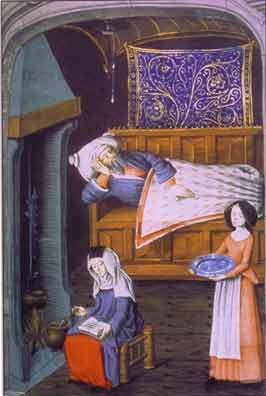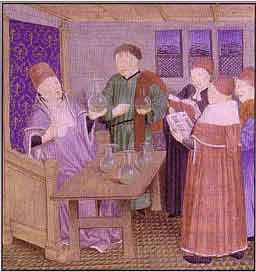| Archery |
| Brewing |
| Calligraphy & writing |
| Combat |
| Cooking |
| Dance |
| Etiquette |
| Household life |
| Medicine |
| Music |
| Needlework |
| Playacting |
| Religion |
| Storytelling |

| Where minor ailments were concerned,
it was usually women who prepared herbal simples in the still room; all
aspects of childbirth and gynaecology were also their preserve. Indeed
women were often respected for their practical medical knowledge, although
the university trained physicians (who did no practical training but studied
the theories of Galen, Hippocrates and Avicenna) dismissed them as worthless
and interfering. Illness was thought to result from an imbalance of the
humours and it was necessary to take into account the natural disposition
of the patient to be sanguine, choleric, phlegmatic or melancholy –
characteristics determined by varying proportions of the four elements:
earth, air, fire and water. Bleeding was often a first resort in cases
of illness, purging another favourite. Queen Elizabeth was frequently
irate when members of her court, often to avoid some unpleasant duty or
confrontation, pleaded that they had “taken physic” and could
not attend. Physicians make their diagnosis chiefly by the examination
of urine: the patient need not even be present! |

Studying the colour of urine in a "jordan" or urine flask
Curiously to our modern minds, the remedies were
often successful. Surely it is not coincidence that the treatment for
migraine was to bleed from the vein between thumb and first finger –
the acupuncture/pressure point used to treat migraine today! Remedies,
the terrible threat posed by plague, smallpox and sweating sickness, the
role of the physician, barber and surgeon and contemporary ideas about
medicine were described and discussed. Two of our members studied medical herbalism - the remedy of most frequent resort in the past because of its availability to almost everyone They covered the historical aspects of the subject as part of their course and were able to show how most of the old remedies were, indeed, effective in alleviating many conditions. Elizabeth demonstrated a good wife’s medicine chest: what is in it and why. Most of us are able to enthuse about the subject and the other members of the group came to choose herbal treatments by preference for headaches, wounds, burns, insomnia etc. Many sites had herb gardens, providing the opportunity to show people the appearance and scent of the growing herbs. |